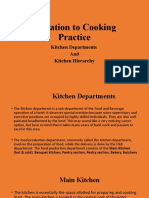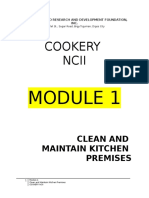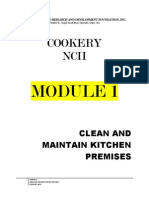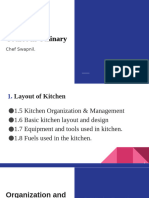Kitchen Essentials
Kitchen Essentials
Uploaded by
princess.gapol96Copyright:
Available Formats
Kitchen Essentials
Kitchen Essentials
Uploaded by
princess.gapol96Copyright
Available Formats
Share this document
Did you find this document useful?
Is this content inappropriate?
Copyright:
Available Formats
Kitchen Essentials
Kitchen Essentials
Uploaded by
princess.gapol96Copyright:
Available Formats
Distinguish the Duties and
Responsibilities of the
Kitchen Brigade
T HE KITCHEN BRIGADE SYSTEM is an
established chain of command in
the kitchen. Its purpose is to streamline
the work in the kitchen, making each
worker more efficient. Food production
is quicker, with uniform results. In this
unit, you will learn about the history of
the kitchen brigade system and how it
is used today.
Objective:
þ Describe the kitchen brigade system.
Key Terms:
Ñ Careme
chef de partie
Georges Auguste
Escoffier
mise en place
organization
classical cuisine guild resource management
commis haute cuisine responsibilities
executive chef hors d’oeuvres sous chef
kitchen brigade system workstations
Kitchen Brigades
Restaurants began in France, where recipes, or formulas, first were recorded. The act of
writing down the methods and techniques allowed chefs to be trained in ways other than
apprenticeship. Culinary schools, for example, became an option (e.g., Le Cordon Bleu and
Les Trois Gourmands in Paris).
E-unit: Distinguish the Duties and Responsibilities of the Kitchen Brigade
Page 1 u www.MyCAERT.com
Copyright © by CAERT, Inc. — Reproduction by subscription only. 700001
ORIGIN
The modern day culinary profession began with the formation of a culinary guild, or a pro-
fessional organization, that focused on the craft of food preparation. The guild monitored:
t Who could perform various types of food preparation
t Which foods were to be used for typical culinary dishes
t How the food dishes were to be prepared
A person identified only as “Monsieur Boulanger,” who was originally a vendor of soup in
Rue Bailleul, owned a pub and decided to prepare and sell food items in his establishment.
The guild sued him on the grounds that only guild-approved individuals should be allowed to
sell food products and services to the public.
Boulanger won his case against the guild and re-opened his pub. He is said to have mar-
keted his soup with a sign that read “Boulanger’s soups are restorative.” He is credited with
coining the term “restaurant” from “restorative,” which marked the beginning of the restaurant
industry.
CAREME
Marie-Antoine Careme is the late 19th-century chef who created and institutionalized the
cooking methods and standards known as haute cuisine. Haute cuisine, or grande or high
cuisine, is a style of food preparation that takes many hours to prepare because of the elaborate
preparations and principles involved. Grande cuisine style continues in very fine dining estab-
lishments and hotels today and includes garnishing and sculpting a customer’s plate, as some-
one would construct artwork. It may take approximately 12 to 14 hours to prepare a cus-
tomer-ordered meal.
GEORGES AUGUSTE ESCOFFIER
Georges Auguste Escoffier, a 19th-century French chef, is considered the father of the
culinary arts and founder of the kitchen brigade system. The kitchen brigade is comprised of a
team of chefs with specific duties that help to simplify food production in contrast to the
grande cuisine style of food preparation, which requires more time, ingredients, and labor.
Escoffier made French cuisine world famous and his seminal cookbook, Le Guide Culinaire,
was first published in 1903. The seemingly simple act of documenting common food prepara-
tion methods and techniques has made it possible for the culinary arts to be shared with all
who wish to know how to cook.
Prior to the publication of Le Guide Culinaire, people were required to apprentice with a
pastry chef to learn how to prepare pastry or to apprentice with a garde-manger to learn how to
prepare hors d’oeuvres or forcemeats. Escoffier developed several other practices that were
E-unit: Distinguish the Duties and Responsibilities of the Kitchen Brigade
Page 2 u www.MyCAERT.com
Copyright © by CAERT, Inc. — Reproduction by subscription only. 700001
very influential in the 19th-century restaurant industry. His classical cuisine style of cook-
ing:
t Uses the freshest and highest quality ingredients
t Uses refined cooking techniques (in contrast to the laborious Grande Cuisine style)
t Structured and documented the methods and techniques to create the “Mother Sauces”
used by restaurants worldwide
PURPOSE OF THE KITCHEN BRIGADE SYSTEM
The purpose of the kitchen brigade system is to simplify food production by organizing
food preparation and sanitation tasks. In addition, the system makes it possible to conserve
resources.
Simplify Food Production
Organization is a plan developed to minimize
chaos and to produce superior products by assigning
people to specific tasks and kitchen areas. Escoffier
identified titles for the kitchen brigade positions and
helped make food production run like a well-oiled
machine.
Chefs who remain focused on one task or menu
category rather than being responsible for multiple
tasks can repeatedly produce superior products.
Focused tasks allow chefs or cooks to become profi-
cient in their duties and to remain in dedicated
workstations. Workstations are areas of the kitchen
dedicated to specific food production tasks. For
instance, a kitchen may have a pastry station and a
vegetable station. Each workstation should include
the equipment (e.g., a refrigerator, oven, or mixer)
needed to accomplish the station’s tasks.
Responsibilities are duties chefs or cooks are
assigned to complete with accuracy and efficiency;
they must meet specified preparation and presenta- FIGURE 1. The kitchen brigade system utilizes
tion standards. If one chef fails to complete his or her workstations dedicated to specific food production
tasks, such as preparing and chopping vegetables.
duties, the entire food production process suffers, and
the customer’s meal is delayed.
E-unit: Distinguish the Duties and Responsibilities of the Kitchen Brigade
Page 3 u www.MyCAERT.com
Copyright © by CAERT, Inc. — Reproduction by subscription only. 700001
Conserve Resources
Resource management is a plan that helps ensure that facility resources are used in the
most efficient manner possible. Food production resources are carefully monitored to ensure
business prosperity. Each chef or cook is assigned specific food preparation responsibilities for
the menu to avoid duplication of effort.
Time
Time is an important economic resource of the restaurant. Chefs utilize mise en place,
which is a French term for “put in place.” According to mise en place, chefs should prepare in
advance any ingredients that will be used when the food dishes are ordered. This includes
gathering ingredients; chopping vegetables for soups, salads, and stocks; par baking or cooking
foods (e.g., spaghetti and vegetables); and preparing the stocks or sauces to add to dishes.
Finances and Energy
Good financial management is just as important as good food to a restaurant’s success.
Good food and poor financial management usually result in business failure. Restaurant suc-
cess depends, in part, on energy conservation. Labor is an example of a human resource that
should result in task completion with minimal wasted effort. Utility costs, which represent the
amount of energy used to operate the restaurant, are another area in which conservation is
critical.
Goods
Food service goods are another restaurant resource and fall into three categories: durable,
semi-durable, and non-durable goods. Durable goods are goods that last many years, if not a
lifetime. Examples are facilities, equipment, and furniture. Semi-durable goods are goods that
may be used several times, but they do not last for extended periods of time. Examples are
cloth table covers and napkins, aprons, and towels. Non-durable goods are one-use items, such
as food, disposable table service, and centerpiece flowers.
DUTIES AND RESPONSIBILITIES
Running a successful restaurant requires hiring excellent employees, such as an executive
chef, a sous chef, and a chef de partie.
Executive Chef
The executive chef is the first in command of food production and food production
employees in a restaurant kitchen. He or she is responsible for menu planning, for the addition
of new recipes and dishes to the menu, and for supervising all food production positions. The
executive chef is also responsible for the kitchen budget, invoices, inventory, and purchasing.
A chef typically wears a uniform designed to minimize injuries and sanitation risks. The
standard daily dress for an executive chef includes a tall chef hat called a toque, a necktie or
E-unit: Distinguish the Duties and Responsibilities of the Kitchen Brigade
Page 4 u www.MyCAERT.com
Copyright © by CAERT, Inc. — Reproduction by subscription only. 700001
neckerchief, a double-breasted chef jacket, trousers,
clogs or other shoes, and an apron. Chefs generally wear
no jewelry, but a wedding ring may be allowed.
To ensure that food production standards are met,
the executive chef must meet educational or training
standards. A chef may receive educational training
through an accredited culinary school or through an
apprenticeship system. Various certifications and
degrees are available, such as an associate’s degree and a
bachelor’s degree in culinary arts. A culinary student or
intern may use the apprenticeship system to achieve
experience in food production. A commis is an appren-
tice cook who job shadows a professional chef. The
commis often works in a food production establishment
while enrolled in a culinary education program. The
apprenticeship system enables a student to gain experi-
ence and to improve his or her skills. Generally, a
commis position will last for two to four years.
The salary range for an executive chef is typically
between $95,000 and $150,000, based on experience, FIGURE 2. The standard daily dress for a chef
degrees or certifications, training, and the size and includes a toque, a neckerchief, and a
double-breasted jacket.
prominence of the establishment. For instance, an exec-
utive chef at Chili’s would probably be offered a higher
salary than an executive chef at Ponderosa, but a chef at a popular 4-star restaurant in down-
town Chicago, Boston, or Los Angeles would likely earn much more.
Sous Chef
The sous chef is the second in command of the kitchen brigade. He or she assists the
executive chef in carrying out the daily duties and orders. He or she is first in command when
the executive chef is absent. The sous chef’s food production duties may include preparing
sauce and assisting and instructing kitchen brigade personnel in food production and presenta-
FURTHER EXPLORATION…
ONLINE CONNECTION: Culinary School
Use the Internet to research at least three culinary schools. Try to locate one school in your
part of the country, as well as two that are out of state or in another country. Find the admission
requirements for each program. Gather information about the culinary education programs.
Determine what kinds of classes are offered and how long it typically takes a student to com-
plete the coursework and graduate.
E-unit: Distinguish the Duties and Responsibilities of the Kitchen Brigade
Page 5 u www.MyCAERT.com
Copyright © by CAERT, Inc. — Reproduction by subscription only. 700001
tion. The standard daily dress is the same as that for an executive chef, but the sous chef’s
toque is sometimes shorter than that of the executive chef.
The education and training requirements are the same as those for an executive chef. The
sous chef may have less experience than the executive chef and may be working his or her way
up to the executive chef position. The average salary for a sous chef is typically $45,000 and
increases annually, based on experience, education, training, and establishment size.
Chef de Partie
The chef de partie is the line cook or the station chef in the kitchen brigade. This chef is
responsible for specific food production duties in a workstation. When more than one chef de
partie is present, each retains the name of his or her workstation. For example, there may be a
chef de partie du pastry or a chef de partie du garde-manger. These positions have a hierarchy
in the kitchen brigade command system, and the number of positions depends on the estab-
lishment size. A larger establishment will obviously need more positions. The average annual
salary ranges from $25,000 to $35,000. Again, the type and size of the establishment affect the
salary.
Summary:
2 The kitchen brigade is comprised of a team of chefs with specific duties that help
simplify food production by organizing food preparation and sanitation tasks.
French chef Georges Auguste Escoffier is credited with creating the kitchen brigade
system in the 19th century. Focused tasks allow the chef or cook to become profi-
cient in his or her duties and to remain in a dedicated workstation. Resource man-
agement is a plan that helps ensure that facility resources are used in the most effi-
cient manner possible. Resources include time, finances, and goods. The executive
chef is responsible for menu planning, for the addition of new dishes to the menu,
and for supervising all food production positions, such as the sous chef, commis,
and chef de partie.
Checking Your Knowledge:
´ 1. What is the kitchen brigade system?
2. Who is credited with founding the kitchen brigade system?
3. What are a restaurant’s main resources?
4. What are the duties of an executive chef?
5. What is a commis?
E-unit: Distinguish the Duties and Responsibilities of the Kitchen Brigade
Page 6 u www.MyCAERT.com
Copyright © by CAERT, Inc. — Reproduction by subscription only. 700001
Expanding Your Knowledge:
L Arrange to visit a restaurant’s kitchen during the mid-afternoon, when the restau-
rant is less busy. Interview the executive chef and other members of the kitchen bri-
gade. Determine the specific duties for which each person is responsible. What jobs
can be completed in advance, and what jobs are done only after a customer places an
order in the dining room? Find out if there are any jobs in the kitchen brigade that
are not explained in this unit.
Web Links:
: Escoffier
http://www.escoffier.com/index.php/content-categories/escoffier-and-great-
chefs/escoffier-articles/george-auguste-escoffier
Kitchen Brigade
http://chefsblade.monster.com/benefits/articles/208-guide-to-the-kitchen-
brigade-system
Sous Chef
http://recipes.howstuffworks.com/food-facts/food-careers/sous-chef.htm
E-unit: Distinguish the Duties and Responsibilities of the Kitchen Brigade
Page 7 u www.MyCAERT.com
Copyright © by CAERT, Inc. — Reproduction by subscription only. 700001
You might also like
- Dodong Gala X LCIF Recipe-1Document45 pagesDodong Gala X LCIF Recipe-1FRANCINE ANGELA MALABADNo ratings yet
- Pre-Commis Chef - 1Document54 pagesPre-Commis Chef - 1Abdullah AsimNo ratings yet
- 1-Introduction To CookeryDocument26 pages1-Introduction To CookeryEdchel Espeña100% (2)
- Kitchen BrigadeDocument25 pagesKitchen BrigadeAroma RizalNo ratings yet
- Cookery Lesson 1Document16 pagesCookery Lesson 1Marlon GandaNo ratings yet
- Kitchen Departments and Kitchen HierarchyDocument28 pagesKitchen Departments and Kitchen HierarchyAndjelko ŠušićNo ratings yet
- Kitchen Staff Organization: 1. The MenuDocument6 pagesKitchen Staff Organization: 1. The MenuRo NyNo ratings yet
- Kitchen Organisation New TrendsDocument3 pagesKitchen Organisation New Trendsrahulnavet100% (3)
- ngọc1Document269 pagesngọc1Ngọc NguyễnNo ratings yet
- MODULE 1 LESSON 2 1st Sem 2022 23Document26 pagesMODULE 1 LESSON 2 1st Sem 2022 23althealouielajoyNo ratings yet
- Core Concepts in Cookery 1Document32 pagesCore Concepts in Cookery 1吴振安No ratings yet
- WEEK 10-Introduction To Culinary Arts UPDDocument20 pagesWEEK 10-Introduction To Culinary Arts UPDChristin Me LocsinNo ratings yet
- Lesson Guide - Lesson 1 - Week 1Document6 pagesLesson Guide - Lesson 1 - Week 1Shenn Silva RockwellNo ratings yet
- Kitchen Birgit Ashish-2Document34 pagesKitchen Birgit Ashish-2mahendar chuphalNo ratings yet
- Kitchen Organisation NewDocument16 pagesKitchen Organisation NewProbaron BaruahNo ratings yet
- Cookery - Module 1Document120 pagesCookery - Module 1Ehmz G. LaronNo ratings yet
- Cookery Ncii: Clean and Maintain Kitchen PremisesDocument117 pagesCookery Ncii: Clean and Maintain Kitchen PremisesKhan Nur100% (1)
- Cookery Module 1Document117 pagesCookery Module 1Yvonne Janet Cosico-Dela FuenteNo ratings yet
- COOKERY - Module 1Document117 pagesCOOKERY - Module 1Clark Inovejas50% (4)
- 1332 Unit 2 Classical BrigadeDocument7 pages1332 Unit 2 Classical BrigadeRoopkatha ChattopadhyayNo ratings yet
- Hierarchy & Kitchen Organisation UpdatedDocument36 pagesHierarchy & Kitchen Organisation UpdatedbhatkhandeshreejitNo ratings yet
- 01 Kitchen Essentials and Basic Food Preparation Overview 1Document10 pages01 Kitchen Essentials and Basic Food Preparation Overview 1khen davidNo ratings yet
- No 3 Classical Kitchen BrigadeDocument14 pagesNo 3 Classical Kitchen BrigadeKMCTCOLLEGEOFHOTELMANAGEMENT ANDCATERINGTECHNOLOGYNo ratings yet
- Kitchen Staff OrganizationDocument41 pagesKitchen Staff OrganizationKïtëł Gägüï100% (1)
- Is The Art of Preparing and Cooking FoodsDocument2 pagesIs The Art of Preparing and Cooking FoodsAshira Fae TnmnNo ratings yet
- The Organization of Modern KitchensDocument9 pagesThe Organization of Modern KitchensJohnson Macayan FernándezNo ratings yet
- HM 211 - Part 2 - Brigade de CuisineDocument20 pagesHM 211 - Part 2 - Brigade de Cuisineadw awdawNo ratings yet
- Open Kitchen ManagementDocument9 pagesOpen Kitchen Managementchef eko adityoNo ratings yet
- Unit: 1 Professional Kitchen and CookingDocument156 pagesUnit: 1 Professional Kitchen and CookingHImanshu SinghNo ratings yet
- Culinary Terminology - Assigment 1Document2 pagesCulinary Terminology - Assigment 1Gary Roach100% (1)
- Kitchen Organization and Safety SanitationDocument44 pagesKitchen Organization and Safety SanitationBSBALAGUNZAD JHANE100% (1)
- Prepared by Yubraj Balami Yogendra Magar Unish RaiDocument28 pagesPrepared by Yubraj Balami Yogendra Magar Unish RaiKumar Satyam100% (1)
- Week 1 Intro To Principles of Food ProductionDocument37 pagesWeek 1 Intro To Principles of Food ProductionAngelica SorianoNo ratings yet
- TVL 1 COOKERY LESSON 1 KITCHEN BRIGADE AutosavedDocument105 pagesTVL 1 COOKERY LESSON 1 KITCHEN BRIGADE AutosavedAl Lhea Bandayanon MoralesNo ratings yet
- Culinary Art SemDocument41 pagesCulinary Art SemKrunal VishwasraoNo ratings yet
- Topic 1 Definition and HistoryDocument14 pagesTopic 1 Definition and HistorySIHTM Faculty Wendell L. GalapateNo ratings yet
- Topic 11 (Kitchen Brigade & Liaison With Other Departments)Document3 pagesTopic 11 (Kitchen Brigade & Liaison With Other Departments)babu197100% (1)
- The 223 - Midterm ModuleDocument94 pagesThe 223 - Midterm ModuleLULU, JocelynNo ratings yet
- 1 Year Notes BTKDocument55 pages1 Year Notes BTKShivansh SharmaNo ratings yet
- Jurnal 1Document3 pagesJurnal 1Alfiyyah ayuNo ratings yet
- Henry IV Industrial Revolution: History of Culinary ArtsDocument20 pagesHenry IV Industrial Revolution: History of Culinary ArtsJoemar BenitoNo ratings yet
- Cookery nc2Document10 pagesCookery nc2Shemaiah D. SimonNo ratings yet
- MODULE WEEK 4Document5 pagesMODULE WEEK 4curatokensheengwenNo ratings yet
- 01 Kitchen Operation MEETING 1STDocument16 pages01 Kitchen Operation MEETING 1STIlma Indriasri PratiwiNo ratings yet
- Kitchen Essentials ReviewerDocument2 pagesKitchen Essentials ReviewerEmeonz YacalNo ratings yet
- Culinary ArtsDocument17 pagesCulinary Artsasdv asdfaNo ratings yet
- Layout of Kitchen FY BAICADocument41 pagesLayout of Kitchen FY BAICAshivammitbaokarNo ratings yet
- The Kitchen Hierarchy Explained: What Is The Brigade de Cuisine?Document10 pagesThe Kitchen Hierarchy Explained: What Is The Brigade de Cuisine?Nathaniel VenusNo ratings yet
- Applied Ethics - Career Portfolio FinalDocument18 pagesApplied Ethics - Career Portfolio FinalkholeensendrienesheensNo ratings yet
- 1st Year BCT & BHM FPP Notes-1Document261 pages1st Year BCT & BHM FPP Notes-1ArbaazNo ratings yet
- Hierarchy Area of Department & KitchenDocument5 pagesHierarchy Area of Department & KitchenChef Umesh JugranNo ratings yet
- Introduction Kitchen Essentials Unit 1Document27 pagesIntroduction Kitchen Essentials Unit 1Daisy PanilagaNo ratings yet
- Food Production BHIC1Document19 pagesFood Production BHIC1Katson IvyNo ratings yet
- Duties &responsibilitiesDocument8 pagesDuties &responsibilitiesarjun arjunNo ratings yet
- ST Peters Lutheran College Hospitality: THHHCO01B: Develop and Update Hospitality Industry KnowledgeDocument39 pagesST Peters Lutheran College Hospitality: THHHCO01B: Develop and Update Hospitality Industry KnowledgeOliver FabonNo ratings yet
- The Food-Service Industry: © Dan LipowDocument18 pagesThe Food-Service Industry: © Dan LipowJulie Mae Guanga LptNo ratings yet
- Module - Kitchen EssentialsDocument8 pagesModule - Kitchen Essentialsma. emely flores100% (2)
- Multicooker Everything: Delicious Recipes for Your Multicooker, Pressure Cooker or Instant PotFrom EverandMulticooker Everything: Delicious Recipes for Your Multicooker, Pressure Cooker or Instant PotNo ratings yet
- Catering and Food Services Recipe for Fifty: Kitchen Operation and Management and European and Asia CulinaryFrom EverandCatering and Food Services Recipe for Fifty: Kitchen Operation and Management and European and Asia CulinaryNo ratings yet
- Larousse Gastronomique: The World's Greatest Culinary Encyclopedia, Completely Revised and UpdatedFrom EverandLarousse Gastronomique: The World's Greatest Culinary Encyclopedia, Completely Revised and UpdatedRating: 4.5 out of 5 stars4.5/5 (185)
- My Experience of Having A Family Dinner in A Famous RestaurantDocument3 pagesMy Experience of Having A Family Dinner in A Famous RestaurantXyeda Sara100% (1)
- Food and Drinks Flashcards Fun Activities Games Picture Dictionari - 77962Document23 pagesFood and Drinks Flashcards Fun Activities Games Picture Dictionari - 77962Renata RochaNo ratings yet
- Oats Idli Recipe - Low Calorie Indian Breakfast Recipe HealthyDocument1 pageOats Idli Recipe - Low Calorie Indian Breakfast Recipe HealthytestdatasNo ratings yet
- Waldorf SaladDocument6 pagesWaldorf SaladAnsya19No ratings yet
- Andhra CuisineDocument7 pagesAndhra CuisineSunil KumarNo ratings yet
- Mess Menu 16 Sep To 30 Sep 19Document2 pagesMess Menu 16 Sep To 30 Sep 19Amaterasu Susanoo TsukuyomiNo ratings yet
- Indice Glucemico Lacteos y MasDocument8 pagesIndice Glucemico Lacteos y MasRenata MalquichaguaNo ratings yet
- Cookery - 10 - Fourth ExamDocument5 pagesCookery - 10 - Fourth Examsaaaaavv0.0No ratings yet
- Literature Review On Italian CuisineDocument7 pagesLiterature Review On Italian CuisinewonopwwgfNo ratings yet
- Our MenuDocument4 pagesOur MenueatlocalmenusNo ratings yet
- Ordering at A RestaurantDocument23 pagesOrdering at A RestaurantRicardo SuHerNo ratings yet
- Chinese Tea Eggs, An Authentic Recipe - The Woks of LifeDocument2 pagesChinese Tea Eggs, An Authentic Recipe - The Woks of LifeJoanneNo ratings yet
- Sri Surya Catering Service: Menu BookDocument2 pagesSri Surya Catering Service: Menu BookrahulNo ratings yet
- Ingredients Used in SandwichesDocument53 pagesIngredients Used in SandwichesleahNo ratings yet
- Koloyan Fam Trip 25-27 Feb 22Document3 pagesKoloyan Fam Trip 25-27 Feb 22cliff davisNo ratings yet
- Huevos - Parentingchaos - Com-Deliciously Rotten Deviled EggsDocument6 pagesHuevos - Parentingchaos - Com-Deliciously Rotten Deviled EggsinalambricNo ratings yet
- Matrix U File - EuDocument2 pagesMatrix U File - EuTine SevNo ratings yet
- D. Fill in The Text With These Verbs, in The Right Form:: Read Play Cook Smile Watch Sleep Listen DrinkDocument2 pagesD. Fill in The Text With These Verbs, in The Right Form:: Read Play Cook Smile Watch Sleep Listen DrinkMrWizNo ratings yet
- Slowcooker: Manual & RecipesDocument20 pagesSlowcooker: Manual & RecipesDavid HillNo ratings yet
- Vanilla Cake 2023 Rate Chart 1Document3 pagesVanilla Cake 2023 Rate Chart 1api-626296985No ratings yet
- Prepare Vegetable, Fruit, Eggs and Farinaceous Dishes SITHCCC008 - PowerpointDocument78 pagesPrepare Vegetable, Fruit, Eggs and Farinaceous Dishes SITHCCC008 - PowerpointJuan Diego Pulgarín Henao75% (4)
- ThanksgivingDocument1 pageThanksgivingNa Ramírez IngebretsenNo ratings yet
- Cooking and Eating Ielts Speaking Part 2 British English TeacherDocument4 pagesCooking and Eating Ielts Speaking Part 2 British English TeacherMike PrestonNo ratings yet
- Menu - Back Yard Burgers in USADocument7 pagesMenu - Back Yard Burgers in USAchefchadsmithNo ratings yet
- UntitledDocument22 pagesUntitledSyahputra RidhoNo ratings yet
- DIFFERENT TYPES OF BUFFETDocument10 pagesDIFFERENT TYPES OF BUFFETRachelle BalahadiaNo ratings yet
- Dbs Paylah Hawker ListDocument224 pagesDbs Paylah Hawker ListJohn LebizNo ratings yet
- Culinary Fundamentals With Lab: Lesson 5Document21 pagesCulinary Fundamentals With Lab: Lesson 5Katrina Bianca Buot PiencenavesNo ratings yet
- ZEN 28 Meal Plan and Recipe Booklet+-+European+Cuisine enDocument44 pagesZEN 28 Meal Plan and Recipe Booklet+-+European+Cuisine eniamrezelmNo ratings yet

























































































